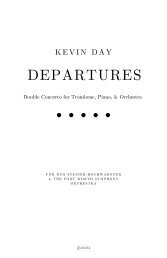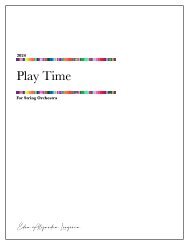Salon Morisot-Jodie Blackshaw
Create successful ePaper yourself
Turn your PDF publications into a flip-book with our unique Google optimized e-Paper software.
<strong>Salon</strong> <strong>Morisot</strong><br />
<strong>Salon</strong> <strong>Morisot</strong> (the <strong>Morisot</strong> Exhibition) is<br />
inspired by three artworks by Berthe<br />
<strong>Morisot</strong>, that represent a challenging<br />
time in her life: 1869-1884. <strong>Morisot</strong> was<br />
torn between her passion for art and the<br />
desire to marry and become a Mother. It<br />
is this tension that forms a central theme.<br />
T REHEARSAL NOTES T<br />
I – The Harbor at Lorient<br />
The first movement ‘Majesty’ is inspired by<br />
the artwork ‘The Harbor at Lorient’, painted in 1869. The artwork beautifully captures the reflective nature of water and<br />
features a lone female figure observing the grandeur of the tall ships. The woman is her sister Edma, who had recently married<br />
and moved away from the family home. The sisters were both avid painters and consequently were very close. They found<br />
their separation very difficult. Hence in this movement, I have attempted to capture not only the majesty of the ships, but the<br />
profound sense of loss as displayed by the sole woman sitting on the wall.<br />
III – Enchantment<br />
II – Devotion<br />
In 1873 <strong>Morisot</strong> painted ‘The Cradle’, again representing her sister Edma<br />
with a new born infant. The baby is Edma’s little girl Blanche, Berthe’s<br />
niece. Again, the painting represents tension. This can be found in Edma’s<br />
expression and how she holds her fingers in her right hand. The<br />
juxtaposition of the light background behind her sister and the dark<br />
background surrounding the bassinet may also suggest the inner battle<br />
both sisters contended regarding societal expectations and their artistic<br />
pursuits. In this movement I have attempted to capture the thoughts of<br />
Edma <strong>Morisot</strong> at this time – joy, apprehension, hope and pure love whilst<br />
also<br />
Berthe’s<br />
capturing<br />
anxieties<br />
regarding marriage.<br />
The third movement brings about a release from the tension.<br />
‘The Garden at Bougival’ represents the changes that<br />
occurred in Berthe’s life in the decade following ‘The Cradle’.<br />
She married Eugene Manet, Édouard’s younger brother, in late<br />
1874. Eugene was himself a painter but gave up his pursuits to<br />
support Berthe, thus relieving her inner struggle.<br />
i

















